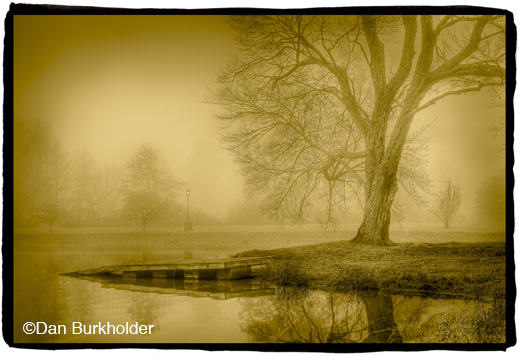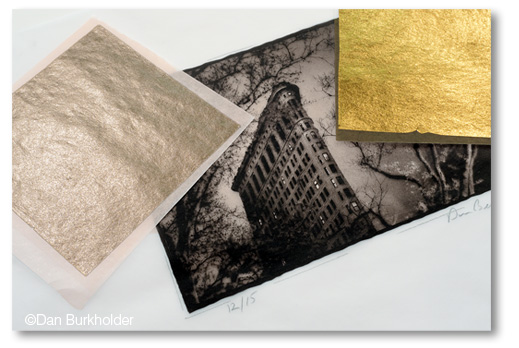Platinum/Palladium on Vellum
over Gold Leaf Prints

The process explained, by Dan Burkholder
Late in 2007 I was feeling antsy after a long binge of inkjet printing. I’d just finished a color project that was presented strictly as larger inkjet prints. The project was  rewarding and the prints looked great but a change-of-gears was definitely in order. Hankering to get back into the darkroom, I also felt a nagging desire to take the handmade print in a different direction. For one, I wanted to make miniature prints, on the order of 4” x 6” and 9” x 13”. Secondly, I really wanted to make prints totally different from those printed on inkjet printers, or for that matter, anything on the market today; something more along the line of hand-made prints from the late 1800’s, but with a modern twist.
rewarding and the prints looked great but a change-of-gears was definitely in order. Hankering to get back into the darkroom, I also felt a nagging desire to take the handmade print in a different direction. For one, I wanted to make miniature prints, on the order of 4” x 6” and 9” x 13”. Secondly, I really wanted to make prints totally different from those printed on inkjet printers, or for that matter, anything on the market today; something more along the line of hand-made prints from the late 1800’s, but with a modern twist.
With a quarter century of platinum/palladium printing under my belt, I began to explore ways to combine yet another precious metal—gold—with the hand-coated platinum/palladium print. Gold has a proud history in photography, having been used in toners and even as dust suspended in banana oil (behind glass positives) by Edward Curtis. Not wanting to reinvent the wheel, I started an exploration that culminated in a body of Platinum/Palladium on Vellum over Gold Leaf prints, many examples of which can be found at Sun to Moon Gallery in Dallas, TX.
The Process
Starting with thin, acid-free vellum, I coat and expose the print pretty much like any other platinum/palladium print.
After the print is developed, cleared, washed, dried and flattened, the 24K gold leaf is applied to the back using an archival size. In the world of gilding, “size” refers to the adhesive that bonds the thin metal leaf to the substrate. Of course, since the viewing light passes through the vellum and the size on its way to reflect off the gold leaf, the size should be transparent as well as archival.
Now that you know that gold is on the back of the paper you’ll have a better understanding of some of the particulars of preparing the negative. Because the gold leaf forms the brightest highlights in the image, the negative’s contrast must be modified to provide rich shadows and glowing metallic highlights.
Taking the Precious Metal Theme
a Step Further
Figure 1 shows a platinum/palladium print about to be sized and gilded. Sharp readers will notice a sheet of 24K gold leaf in the upper right of the photo and a sheet of palladium leaf in the lower left. In a few select images, I am using these two precious metals to give a split-tone look (bi-metal actually) to the finished print. The warm palladium coupled with the glowing gold gives a stunning, one-of-a-kind look to the final print.
 FIGURE 1, Print about to be Gilded with both Gold and Palladium Leaf
FIGURE 1, Print about to be Gilded with both Gold and Palladium Leaf
Figure 2 shows the “Flatiron in Spring, New York” image in its final, two-metal form. The palladium leaf is behind the Flatiron building, giving it a softer warmth; the rest of the image is backed with 24K gold leaf.
 FIGURE 2, Final Platinum/Palladium Print Gilded with Gold and Platinum
FIGURE 2, Final Platinum/Palladium Print Gilded with Gold and Platinum
Combining the Old with the New
Photography’s seemingly unlimited options have been a major tickle for practitioners since the medium took root almost 200 years ago. Discovering new ways to combine historic processes—like platinum/palladium—with precious metasl—gold & platinum leaf—has been nothing short of thrilling for me. And to have such precise tonal control via a digital negative has sweetened the process even more. But in the end it’s the print that matters, and a platinum/palladium over gold leaf print literally shines with a elegance and beauty that is unique in the world of works on paper.
We have a large selection of Platinum/Palladium over Gold Leaf Prints
by Dan Burkholder in stock at Sun to Moon Gallery.
For more information about purchasing fine prints by Dan Burkholder, contact...
Sun to Moon Gallery
1515 E. Levee Street
Dallas, TX 75207
Phone 214.745.1199